Geoff Nicholson's Blog, page 26
January 4, 2020
WALKING UNWOUNDED (AS YET)
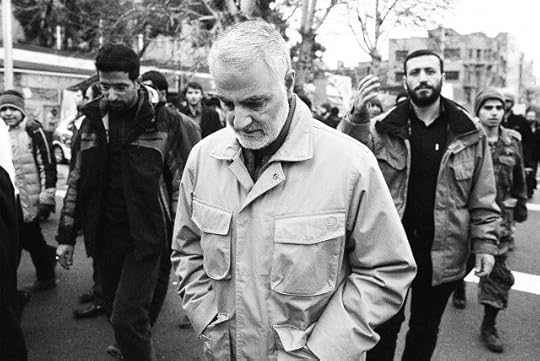
I have no idea of the real politics (or even realpolik) behind the killing of Qasem Soleimani, but I do know that on CNN, Nation Security Analyst Samantha Vinograd said that as a result ‘all American citizens are now walking prime targets.’
Again I have no idea if this is actually true – I’d have thought if you were working on a ranch in Wyoming, the Iranian Quds Force is unlikely to come after you - but in any case I find something strangely tonic about the notion of being a ‘walking target.’ It seems so much better than being a sitting target or even a running target. Let’s take comfort where we can.

Published on January 04, 2020 05:57
December 10, 2019
AS I WAS GOING TO ST IVES ...

During his expedition to Mecca (1851-3) Captain Sir Richard Francis Burton and the rest of his party anchored at a place called Marsa Mahar on the Red Sea.
Burton writes, ‘Wading ashore we cut our feet on the sharp rocks. I remember to have felt the acute pain of something running into my toe; but after looking at the place and extracting what seemed to be a bit of thorn, I dismissed the subject, little guessing the trouble it was to give me.’
It seems he had stepped on a sea urchin, and the foot was so seriously infected that he couldn’t put any weight on it. He had to be carried for part of the journey in a sort of litter or shugduf, and later he rode on a donkey that was itself lame. Various treatments were recommended for the foot but they all failed. Dressing the foot with onion skin only inflamed it further, although by the time he got to Mecca it must have healed – he was fit enough to make a good few enthusiastic circuits of the kaaba.
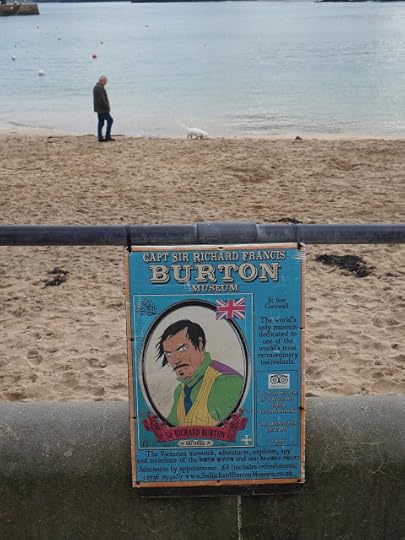
Burton has been on my mind since I was in Cornwall at the weekend, and partly in St Ives which is home to the Captain Sir Richard Francis Burton Museum, in a private house run by one Shanty Baba (conceivably not his real name).
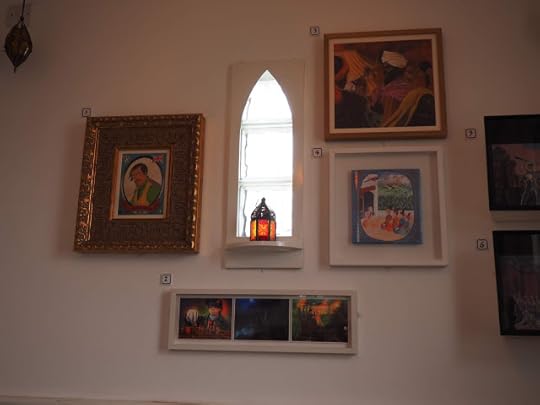
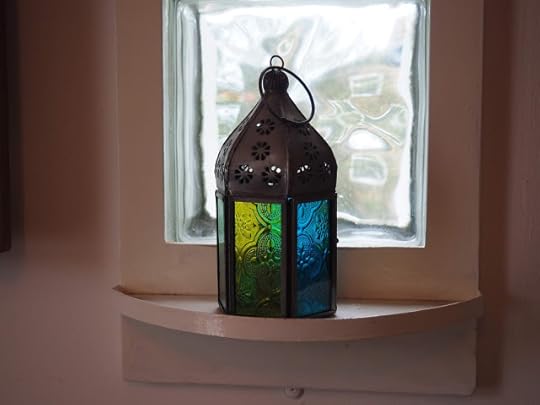
It was great – a kind of son et lumiere, enjoyed while sitting in a room modeled on Burton’s smoking room in Trieste (don’t you find that fewer and fewer of your friends have smoking rooms these days?) surrounded by Burtoniana, including a page from a Burton manuscript, Burton’s medal from the Royal Geographical Society, and this fine little figure, also from the Royal Geographical Society.

There was some walking to be done in St Ives, by me, not by Burton, who as far I can tell never set foot there.
There was Mount Zion and there was Teetotal Street – I’ve searched in vain to find how these places got their names

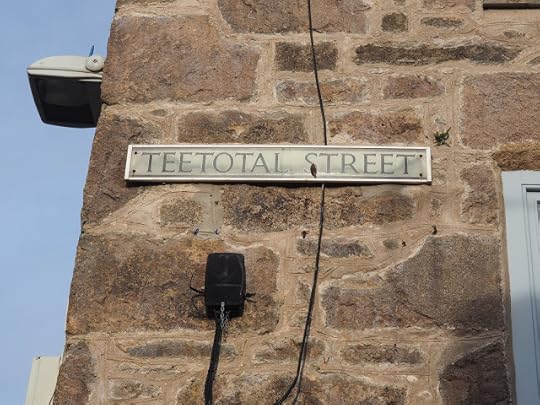
There was also some intriguing ground, for those of you who like that kind of thing.
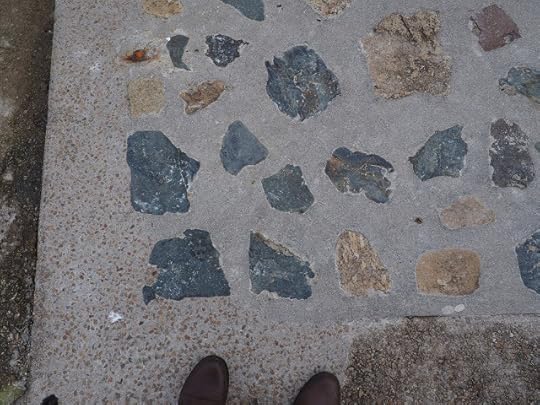
Burton would have been taking notes and measurements, learning Cornish, and probably finding his way to the nearest brothel. I did none of these things. But I did have a Cornish pasty.
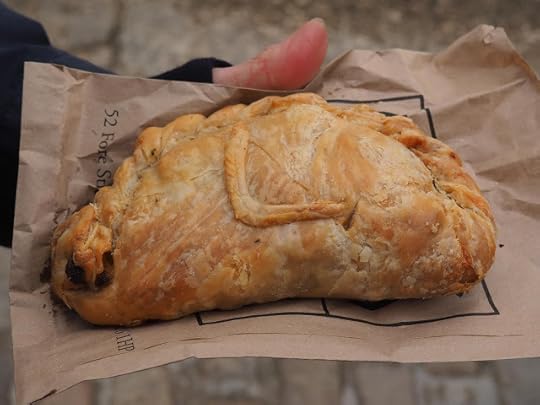
Incidentally, Burton once wrote, 'The dearest ambition of a slave is not liberty, but to have a slave of his own.' I don't know how you'd test the accuracy of that statement, but it seems all too likely to be true.

Published on December 10, 2019 07:14
November 25, 2019
ALL OVER IN DOVERCOURT
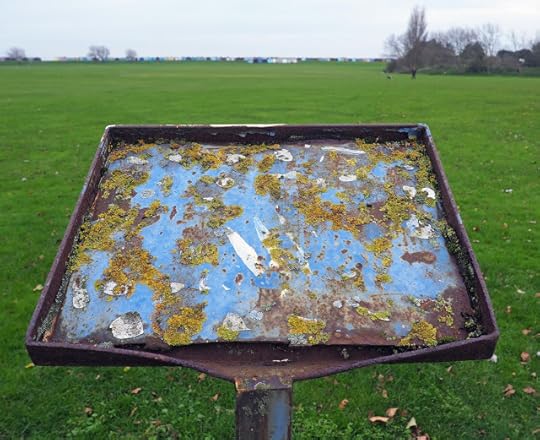
Back in the day, and it was a long day, I had an idea for a sort of travel book to be titled The Seaside in Winter. The pitch was that I’d buy a camper van, a Volkswagen no doubt, and in the course of a long winter I’d travel around the coast of mainline Britain. By day I’d walk and look and feel the wind and rain and icy chill, and in the evening I’d return to the camper, park up, and spend the evening writing up my notes from the day, which would involve reflecting on and savouring the bleak melancholy of deserted seaside spaces.
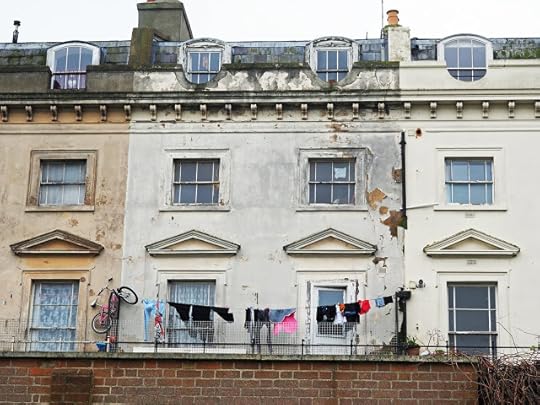
I can still see how it might have worked but I never turned it into a proposal, because I also thought it might be recipe for doom. ‘Promising melancholic young writer found dead by his own hand in VW Camper.’ That might have boosted sales a little, but it wasn’t enough. Yet that doesn’t mean I’ve stopped enjoying the seaside in winter.
And so at the weekend I went to Dovercourt: north east Essex coast, next to Harwich, and the casual flâneur might be hard pressed to say where one town ended and the other one started.
Dovercourt is where Hi Di Hi was filmed, in Warner’s Holiday Camp, renamed Maplins for the show. I wasn’t a regular viewer, but I don’t remember many scenes being shot outdoors, though evidently some were.

Dovercourt in late November had many of the things I thought would be components of my long lost book, even though I’m well aware that late November isn’t truly winter. There was the empty seaside shelter – with pro-Jesus and anti-Satan graffiti.
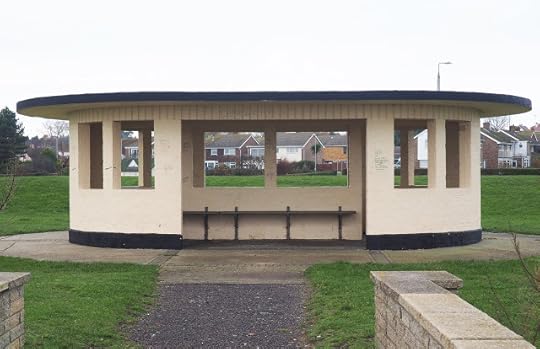
They’ve got two 19th century steampunk(ish) lighthouses (no longer in use):
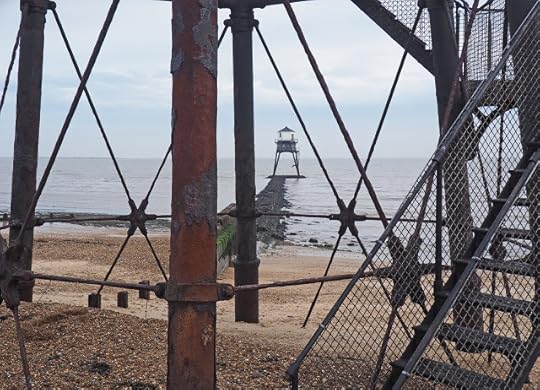
There was crazy golf – I would have played if the kiosk had been open:

And you know I love signs, not least this one,
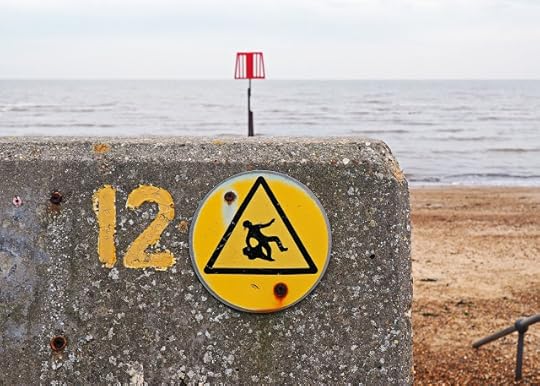
I think, and again I may be wrong, it’s warning you that you could be attacked by a blob of black ectoplasm rising from the beach and attacking you in the trouser region. In general I think life requires a few risks, but I’m all in favour of being warned against that particular danger.
As well as being proper seaside, with groins, lighthouses and (rather small) stretches of beach, Dovercourt also has some serious suburbia, which of course I’m deeply attracted to.

Note how the two bungalows above are apparently mirror images of each other, but they have a different kind of pvc front door and a different kind of lamp adjacent to it. That’ll make a house stand out from all the others, not that everybody in suburbia wants their house to stand out.
Anchors are another option:
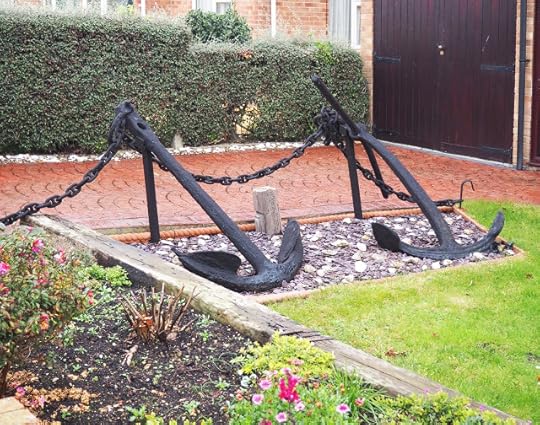
So is a horse:


Published on November 25, 2019 10:41
November 24, 2019
PROBE
Meanwhile Nicholson probed ever deeper into the Obelisk
Jungle of Death.
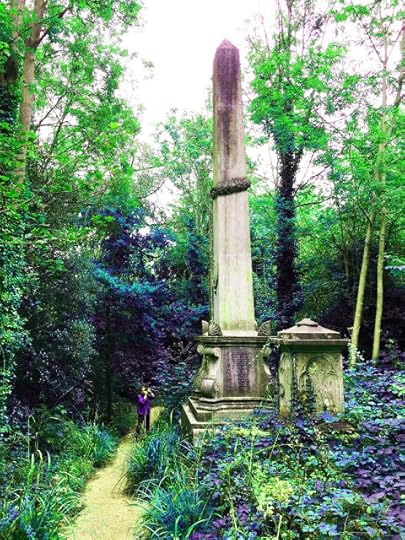
(photo by Yana Wormwood Smith)
Jungle of Death.

(photo by Yana Wormwood Smith)

Published on November 24, 2019 12:40
November 21, 2019
HANGING ON THE HILL
I went on an exploratory drift with my flâneuse pal, and walking tour guide Jen Pedlar (she guides for Footprints of London). The expedition was all hers but I liked that, since it meant I was able to tag along without any sense of responsibility. The walk promised the tunnels of Hanger Lane, various kinds of northwest London suburb and a good old cemetery. You can’t ask for more, can you?
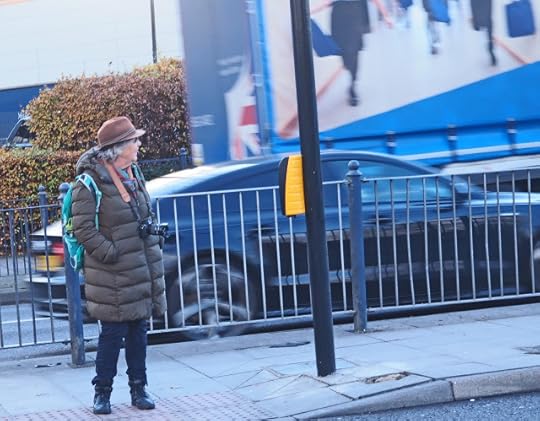
We met at Hanger Lane tube station which is a remarkable thing above ground, like a very low budget flying saucer stranded in the middle of a gyratory system:
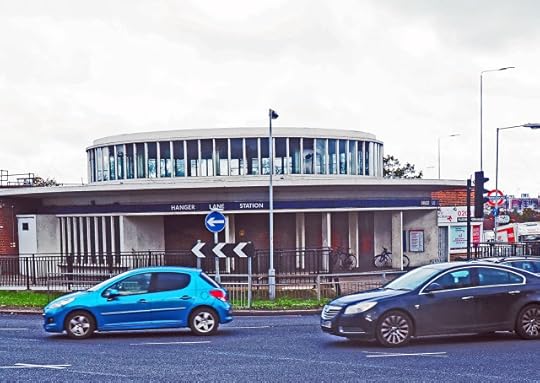
And below ground were the tunnels that looked like this.
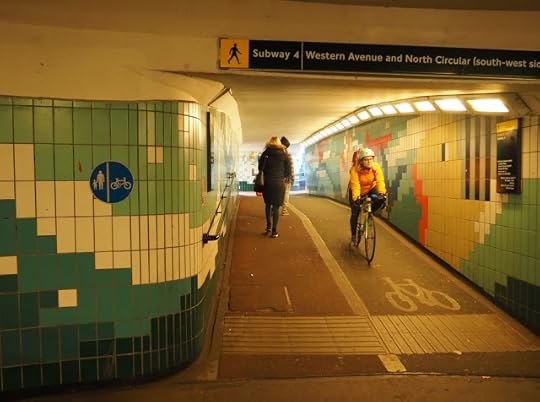
You could perhaps argue that these tunnels were actually a very complicated subway system, but one man’s subway is another woman’s tunnel. The various exits were colour-coded with tiles that had seen better days.

The tunnels seemed cheerful enough in the middle of the day - I mean not all THAT cheerful but I think they’d have seemed a lot less benign at one in the morning.
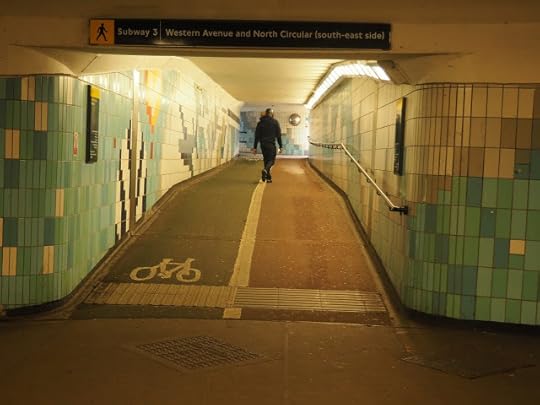
People like to say that London is a collection of villages, but we know it’s mostly a collection of suburbs, some much more appealing than others. The first we came to on our walk was Haymills which was astounding, and in places astoundingly posh, a mix of architectural styles: mid-century modern, streamlined moderne, seaside moderne, and the just downright very fancy; a kind of super suburb.


It was laid out around a series of concentric semi circles
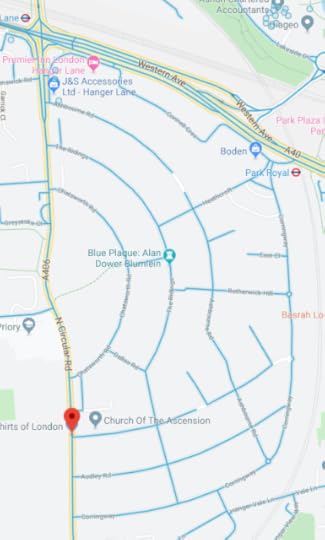
much like the council estate in Sheffield where I grew up
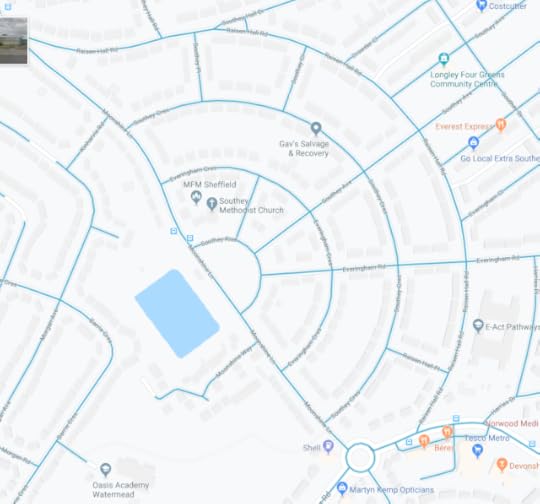
but there the resemblance ended.
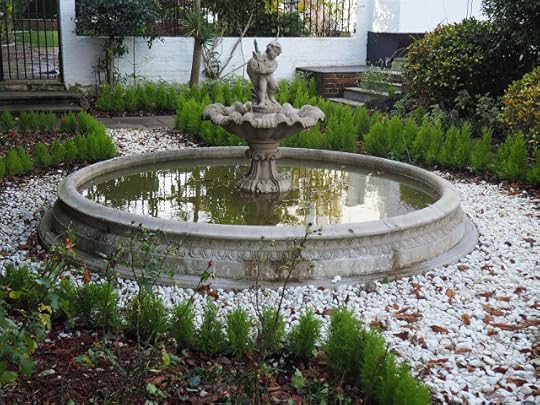

Then we wandered into the Hanger Hill Garden Estate,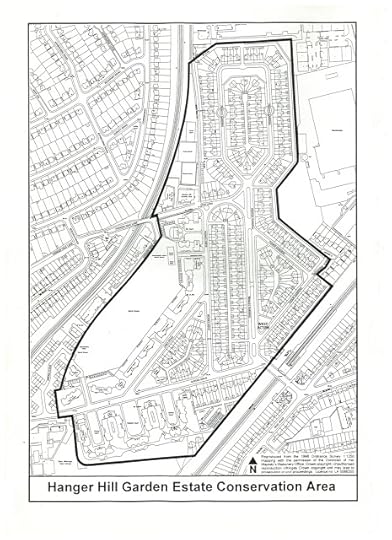 It’s a conservation area, and is by no means not posh, but compared to the other place it seemed modest, well comparatively modest.
It’s a conservation area, and is by no means not posh, but compared to the other place it seemed modest, well comparatively modest.
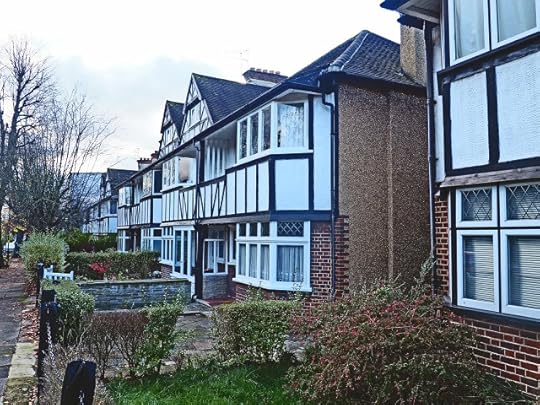
I'm also pretty sure that it has the highest concentration of half-timbered buildings I’ve ever seen.

If local evidence is to be believed these houses, and some of them are converted into flats, are very popular with Japanese buyers and renters – by which I mean that an estate agency named Japan Services appears to be doing some very good business in the area.

And of course we saw all the things there that make suburban walking worthwhile. A stray cat:

a Volkswagen Beetle:

pampas grass:

an inscrutable arrow carved into the pavement:
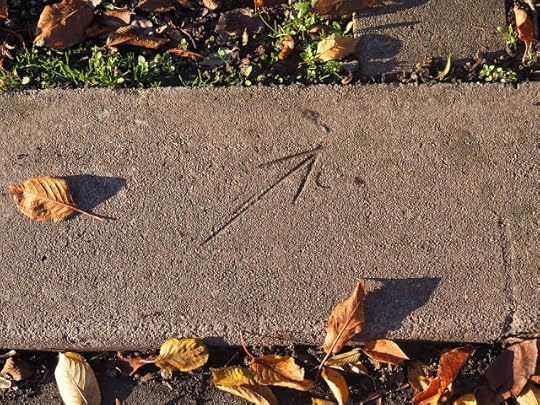
And when we got to the Acton cemetery we went to see the grave of George Lee Temple, the first man to fly a plane upside down (Who knew? – Well, Jen did.) And while we were there, I was able to indulge my taste for obelisks.
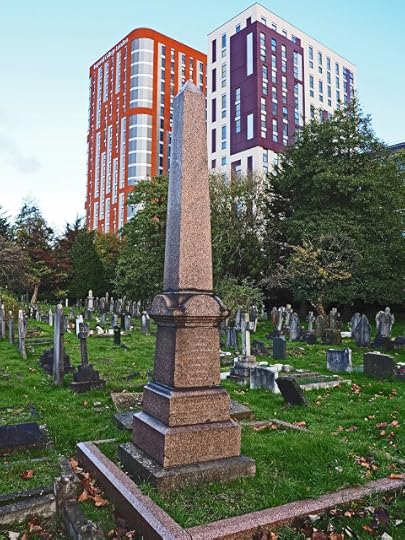
That all adds up to a pretty good day’s drift.
And you know, all the time I was walking through the Hanger Hill Garden Estate, I kept thinking about Osbert Lancaster’s illustration of Stockbroker Tudor.
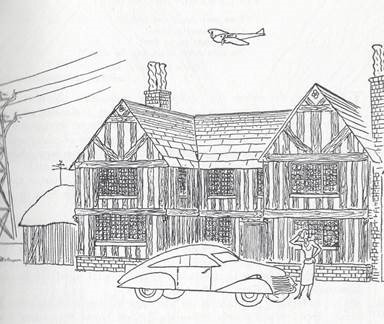
To be fair to Lancaster and indeed to the Hanger Hill Garden Estate, the illustration doesn’t show a half-timbered house, it shows a fully timbered house. The thatched garage is especially fine.


We met at Hanger Lane tube station which is a remarkable thing above ground, like a very low budget flying saucer stranded in the middle of a gyratory system:

And below ground were the tunnels that looked like this.

You could perhaps argue that these tunnels were actually a very complicated subway system, but one man’s subway is another woman’s tunnel. The various exits were colour-coded with tiles that had seen better days.

The tunnels seemed cheerful enough in the middle of the day - I mean not all THAT cheerful but I think they’d have seemed a lot less benign at one in the morning.

People like to say that London is a collection of villages, but we know it’s mostly a collection of suburbs, some much more appealing than others. The first we came to on our walk was Haymills which was astounding, and in places astoundingly posh, a mix of architectural styles: mid-century modern, streamlined moderne, seaside moderne, and the just downright very fancy; a kind of super suburb.


It was laid out around a series of concentric semi circles

much like the council estate in Sheffield where I grew up

but there the resemblance ended.


Then we wandered into the Hanger Hill Garden Estate,
 It’s a conservation area, and is by no means not posh, but compared to the other place it seemed modest, well comparatively modest.
It’s a conservation area, and is by no means not posh, but compared to the other place it seemed modest, well comparatively modest.
I'm also pretty sure that it has the highest concentration of half-timbered buildings I’ve ever seen.

If local evidence is to be believed these houses, and some of them are converted into flats, are very popular with Japanese buyers and renters – by which I mean that an estate agency named Japan Services appears to be doing some very good business in the area.

And of course we saw all the things there that make suburban walking worthwhile. A stray cat:

a Volkswagen Beetle:

pampas grass:

an inscrutable arrow carved into the pavement:

And when we got to the Acton cemetery we went to see the grave of George Lee Temple, the first man to fly a plane upside down (Who knew? – Well, Jen did.) And while we were there, I was able to indulge my taste for obelisks.

That all adds up to a pretty good day’s drift.
And you know, all the time I was walking through the Hanger Hill Garden Estate, I kept thinking about Osbert Lancaster’s illustration of Stockbroker Tudor.

To be fair to Lancaster and indeed to the Hanger Hill Garden Estate, the illustration doesn’t show a half-timbered house, it shows a fully timbered house. The thatched garage is especially fine.

Published on November 21, 2019 07:07
November 15, 2019
WEARY AND/OR LONESOME

I was digging around in the archive looking for something else and I found this in the craw of my hard drive. First there was a quotation:‘He was walking in America, always heading west, dodging cars, walking with ghosts and madmen, with saints and scream queens and with those who refused to ride the bus: Thoreau and Kerouac. Sometimes it was a lonely walk.’
I have no idea where I got this or who it’s a quotation from – Don De Lillo? Steve Erickson? - and searching online revealed nothing. And suggestions? I know I didn’t write it.
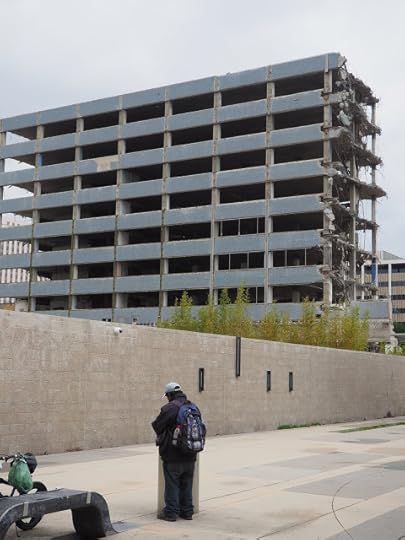
On the other hand I did write this, presumably as the draft of something I intended to use in the blog and forgot about till now: I was walking in downtown Los Angeles, a place where a lot of others walk too. It was a busy weekday lunchtime. The streets were full of people. There was a lot to look at, a lot of distractions, and that was why I wasn’t paying much attention to the youngish, hippie-ish man who was standing not very far away from me as we both waited for the light to change so we could cross the street. He was a panhandler however, and ppparently he’d been trying and failing to get my attention for a while and he thought I was deliberately ignoring him, which was unfair, since I hadn’t been sufficiently aware of him to deliberately ignore him. And now he said loudly, pointedly, in a sneering tone that did finally get my attention, “Hey, who do you think you are? Jack Kerouac?” I have no idea what he meant by that. My physical resemblance to Mr K is non-existant and in any case Kerouac was surely not the kind of man who went around ignoring panhandlers or bums of any kind. He usually embraced them. Still, as sneering insults go, this wasn’t the worst. Kerouac remains a sort of hero mine. I still didn’t respond to the panhandler, but then the light changed and I walked across the street with a big smile on my face. That probably only made things worse for the guy. *

Published on November 15, 2019 05:40
November 9, 2019
RUMMY WALKING
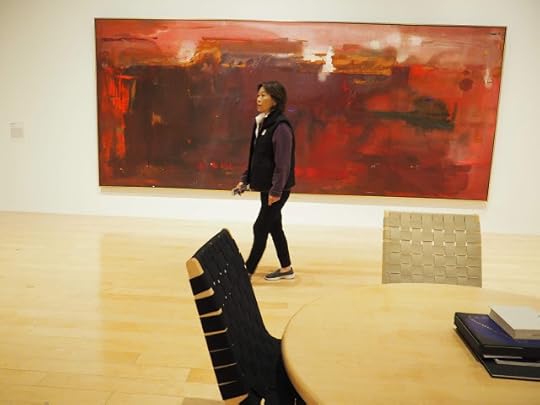
Have we discussed how people walk in art galleries? Maybe we have. But we all know that nobody walks in art galleries the way they do in ‘real life.’ In galleries the walking is ponderous, thoughtful, heavy, a way of showing that you’re taking the art seriously. And of course it’s not real walking, you walk for a bit then you stand for a bit and then you kind of shuffle from one exhibit to the next, then you walk into the next room in the gallery, and so on. We also know that an hour walking round an art gallery is probably the equivalent of a three hour walk in the street.

No great revelations in all this, but I just found a cosmically perfect description of the phenomenon in PG Wodehouse’s – ‘The Rummy Affair of Old Biffy’ written, would you believe, in 1925. Seems like it could have been written this morning. The narrator, naturally, is Bertie Wooster:
‘Well, you know, I have never been much of a lad for exhibitions ..’ That wonderfully inappropriate and maybe self-referential use of the word ‘lad’ gets my chuckle muscles going, and it continues, ‘The citizenry in the mass always rather puts me off, and after I have been shuffling along with the multitude for a quartet of an hour or so I feel as if I were walking on hot bricks.’
Personally I can probably do 45 minutes rather than 15, but otherwise, this describes my exhibition walking experience perfectly.


Published on November 09, 2019 03:05
November 3, 2019
STRAIGHT WALKING
 Richard Long's "A Line Made by Walking"
Richard Long's "A Line Made by Walking"Did you hear about these guys: Robin Heath, Peter Forrester, Jamie Dakota, and Max Barnes? Last month hey decided to walk ‘the longest straight-line walk without a road’ in Great Britain, and it ended not in disaster but in slightly predictable disarray.
It all started with a question asked of the good men and women at Ordnance Survey (lots of background can be found on the OS website) by one Roger Dalton who wrote,‘Hello! An enquiry if I may.....what (and where) is the longest distance you can walk in a straight line in England/Wales/Scotland without crossing a road (defined as a paved surface for vehicular use)?? Planning a potential expedition. Ta!’ The reply came back, ‘So for Great Britain, the longest straight line that you can walk without having to stop, look and listen is 71.5km or 44.43 miles (71500.817767m) and is unsurprisingly in Scotland. Crossing the Cairngorms, the distance goes from 262540, 778255 on the A9 and ends at 328042, 806921 south of the hamlet of Corgarff. The high point is on the summit of Beinn a’Bhuird at 1,179m (3,870ft).They quote Cairngorms expert Eddie Bulpitt who said ‘I wouldn’t recommend anyone do it unless they are very conversant with a map and compass. It is not following known tracks or paths, and it looks like there may well be several scrambles along the way too.’
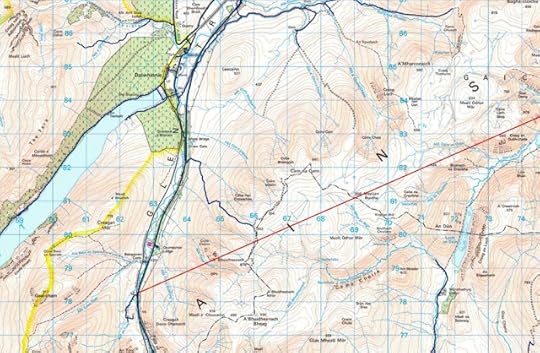
OS adds some relevant maps, that's one of them above, pretty low def, but I think the OS understandably don’t want to give their maps away. I think there’s an issue here. I know the OS are mapmakers, but being able to draw a straight line on a map, isn’t quite the same as having a straight walking route, is it? And does ‘without roads’ really matter? You can walk straight across a road, you walk straight along a road.
Anyway the four merry lads read about this in the papers, mounted an expedition, and were defeated, largely by the weather – rain, cold, boggy ground – and perhaps by their own natures. Some of us know, without putting it to the test, that we’re not up to walking across a bleak stretch of Scotland in mid-October, but evidently some don’t know it.And here’s a map published in the Times showing their route. Maybe I’m mistaken but that really doesn’t look very straight at all.
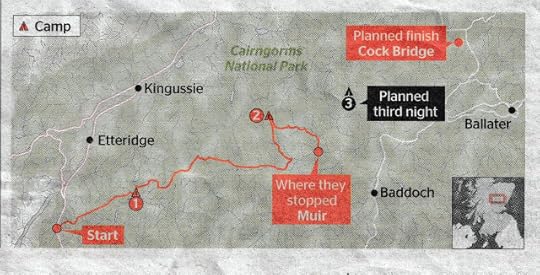
And of course, you might in any case ask what’s so great about walking in a straight line anyway. Allow me to quote Richmal Crompton in Sweet William.‘William walked down the road, whistling his loud, untuneful whistle and kicking a suitably-sized stone from side to side. He wasn’t going anywhere in particular, so it didn’t matter when he got there. Even if he had been going anywhere in particular it wouldn’t have made any difference. William considered it a waste of time to walk straight along the. If there weren’t stones to kick, there were ditches and hedges to investigate, trees to climb … '
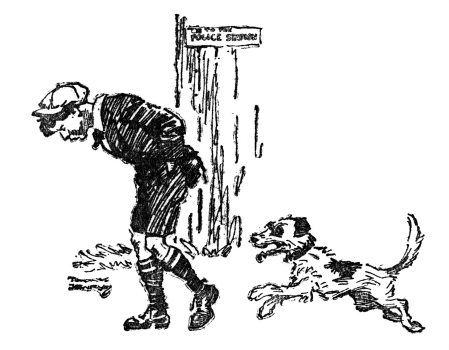

Published on November 03, 2019 10:25
October 30, 2019
YET MORE SANDWICH LORE

If you happen to read Chaka! Through the Fire, the autobiography of Chaka Khan you’ll become aware of a moment in Detroit, after Chaka has played a gig at the Fox Theater when various members of her crew press her to go into a White Castle on the way back to the hotel.
White Castle is, as they say, an American regional hamburger chain with 377 locations across 13 states, mostly in the Midwest, though there did used to be at least one in New York.
This is a White Castle in Detroit though I can’t swear it’s the one Chaka’s crew went to.
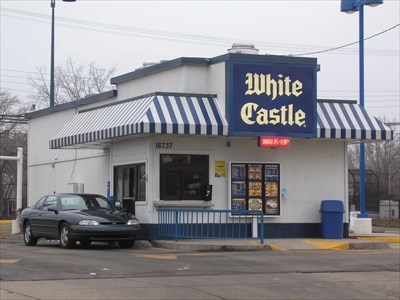
White Castle is famous for its rather small hamburgers, though they obviously do other things too including fish sandwiches.

Chaka is reluctant at first but then ‘wouldn’t you know it, by then, I had a taste for a fish sandwich or two. By the time we reached White Castle, thinking about how tiny their sandwiches are, I’d upped the number to four.’
They arrive at White Castle, a few of them go in, Chaka stays in the limo.
She decides things are moving too slowly so she goes into the White Castle to tell them hurry them up. This has foreseeable consequences.‘In my impatience, I’d forgotten that I wasn’t a “regular” person, or at least, I couldn’t live like one. Clearly my presence was causing chaos.’ so she returns to the limo.
‘When Lisa (one of the backing singers) and the others finally emerged with the food – oops. Lisa had eaten two fish sandwiches too many while waiting for the others.‘“Girl” I was halfway mad. Between the waiting and my appetite ... I really wanted my four!’So she sends Lisa back in.‘When Lisa came out she was trailed by one of the counter girls, with a huge, free bag of fish sandwiches.‘How Beautiful.’Yes indeed what could be more beautiful than a fast food worker giving free food to a rich diva. Did Chaka give the girl a big tip? If so, she doesn’t mention it in the book. She says gave the girl a big hug.

There is in fact a joint in Barcelona named Chaka Khan, that calls itself a ‘gastro bar exotique‘. As far I can tell (I mean, their menu is long, labyrinthine, multilingual and inscrutable) they don’t serve fish sandwiches.


Published on October 30, 2019 04:44
October 22, 2019
SEVEN HILL ARMY

I was walking in Sheffield again. It’s a good place to walk. It has seven hills (no, not much like Rome), but they do keep you fit, if they don’t kill you.
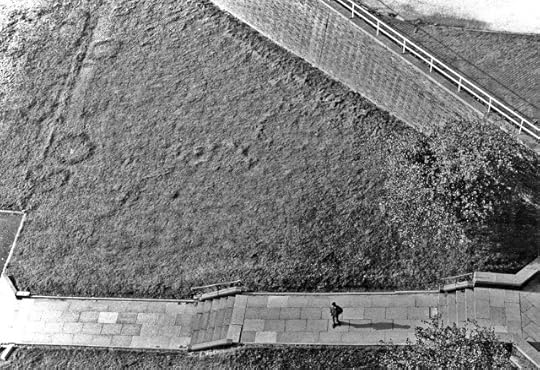
That isn’t me in the photograph above, in fact I don’t know who it is. I took the picture years ago while leaning out of the window of one of these towers, where a friend lived at the time.
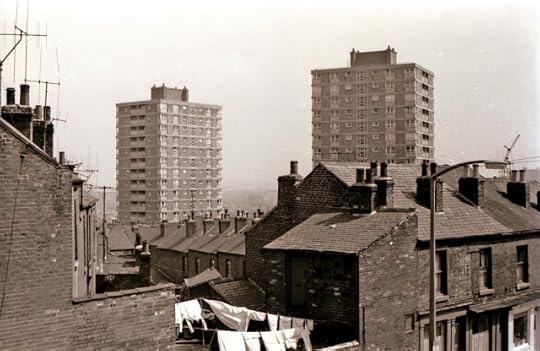
Sheffield has always had ‘interesting’ architecture, little of it truly great, and very little of it genuinely Brutalist. There’s Park Hill of course, now desired by hipsters,

and there used to be the terrifying, now demolished, Kelvin flats,

But those towers always had a certain brut charm about them. I know they weren’t very popular in their day, and my friend was only living there because she was working for the council and they gave her the flat because it was hard to let. But times change.

Today there’s all kinds of zesty new architecture all over the city, a great many towers, and as far as I can tell as an outsider, these aren’t very well loved either.
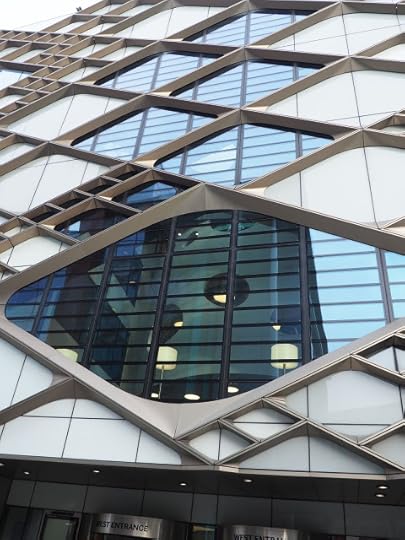
So I was wandering around looking at all the new, computer-generated, Lego buildings, and suddenly there they were – those very towers – which have been given cladding to hide their brutish exteriors.
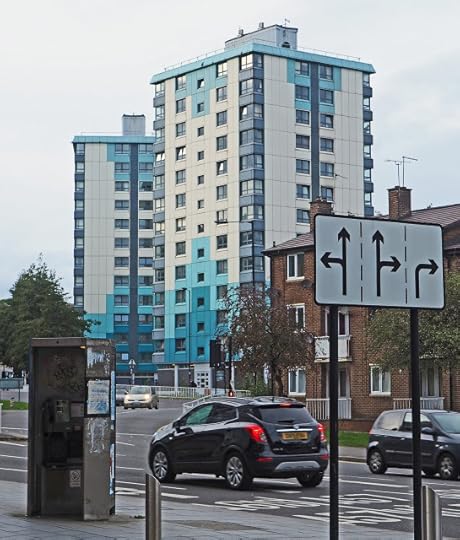
Purists would have sneered at this under any circumstances but I don’t think we quite feel the same way about cladding as we used to.
I also went to look at my parents’ old house: they died a long time ago. It didn’t appear to have changed a bit, which was in some ways the most surprising thing of all.


Published on October 22, 2019 02:06
Geoff Nicholson's Blog
- Geoff Nicholson's profile
- 55 followers
Geoff Nicholson isn't a Goodreads Author
(yet),
but they
do have a blog,
so here are some recent posts imported from
their feed.



